SIEM REAP
We disembarked the RV Mekong Pandaw near Phnom Penh, and we drove north for 4 ½ hours to Siem Reap. Although we would have preferred to disembark in Kompong Chhnang, we did enjoy the sites as we drove north. We went through numerous small villages that we would not have seen if we had disembarked further north, so we were not unhappy with the situation.
We checked in to our hotel – the Angkor Century – by early afternoon. We walked to town to see what we could find.
The town of Siem Reap is low key, and it was appealing to us. Although they have a large tourist industry related to the temples just out of town, the numbers are not apparent in town. There were shops, markets, internet cafes, and many restaurants. A common sign we saw at restaurants catering to westerners advertised ‘no dog, cat, rat, or worms’. What is the carnivore to eat?!
But the reason people travel to Siem Reap is to see the temples, and that was our agenda. There are too many temples to see on one visit, so we decided to focus on the two largest complexes – Angkor Thom and Angkor Wat. We also visited one splendid smaller temple – Ta Prohm.
As mentioned on our ‘Cambodia’ page, the god-king era at Angkor began in the early 9th century when King Jayavarman II assumed the throne. The capital was moved to Angkor, and although it moved around a few times, it returned to Angkor and remained there. Consequently, many temples were built away from Angkor. However, the most in number and opulence were built in and around Angkor – especially by Jayavarman VII who ruled from 1181 to around 1220.
These temples were built for immortal gods, so they were built of the durable materials of brick, laterite, and sandstone. Non-religious buildings were built of less durable materials – mainly wood – and they have not survived. However, the religious buildings have.
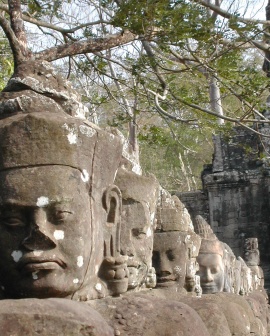
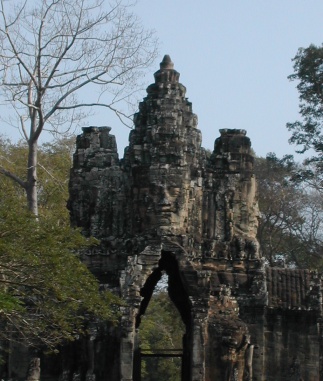
South gate to Angkor Thom
Angkor Thom – which means Grand Angkor – was built by King Jayavarman VII as his palace in the late 12th and early 13th centuries, and it probably remained the capital in to the 17th century. Angkor Thom is more than a palace, more than a temple – it is a city. Within that city are temples of previous and later centuries. The 3 ½ square mile compound is surrounded by a wall that is 26 feet tall and 1.8 miles long on each side. The wall is then surrounded by a 330 foot wide moat. There are five gates leading in to the compound – one at each cardinal point and the fifth Victory Gate. Most visitors approach the compound from the south gate as we did.
As we approached the south gate we saw a huge tower – more than 75 feet tall – with a carved face looking in each of the four cardinal directions, and the actual entrance was through this tower. But to get to the tower, one must cross the moat on a bridge lined on both sides by statues. The figures on the left are gods, and the figures on the right are demons. After crossing the bridge and before passing through the tower, there are carved three-headed elephants plucking lotus flowers with their trunks. These form the pillars on either side of the entrance. The symbolism in all of this is rich and seemingly complex for the uninitiated, but it is interesting even to rookies like us. And then a live elephant strolled out through the gate towards us. All this, and we haven’t even entered the gate yet!
Inside the walls are numerous buildings, temples, and terraces. We walked around to see all of them, but we focused our attention on the Bayon, Bapuon, Royal Palace, Leper King Terrace, and Elephant Terrace.
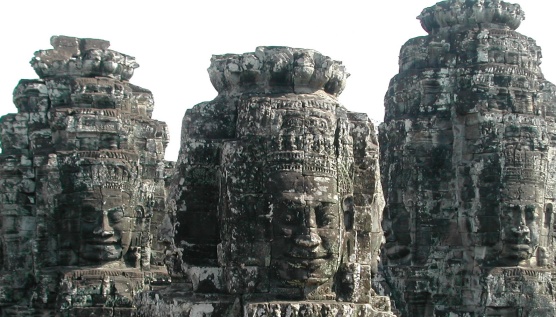
Angkor Thom was developed around the Bayon which was the state temple of Jayavarman VII – a devout Buddhist. It is complex in both structure and meaning.
The Bayon has two outstanding features. First is the complex of face towers that combine to form a stone mountain of ascending peaks. Second is the narrative bas-reliefs of daily life and Khmer history.
The face towers probably originally numbered 49 or 54, but there are only 37 remaining. Some towers have only two or three faces, but most have four faces looking in the four cardinal directions, and the central tower has many more faces. It is quite spectacular.
The bas-reliefs were carved at two separate times. Those on the walls of the outer enclosure were probably done in the early 13th century. Although it is agreed that these depict historical events, it is not known exactly which events those are. There is a lack of continuity that clouds interpretation. The bas-reliefs on the walls of the inner enclosure were probably carved in the late 13th century – probably under Jayavarman VIII who was Hindu rather than Buddhist. These depict Hindu mythology.
The Bapuon is one of the older temples within the Angkor Thom compound. It was the state temple of Yasodkarapura in the 11th century. It is a huge five-tiered pyramid that is in poor condition. However, it is still noteworthy for its small individual bas-relief panels.
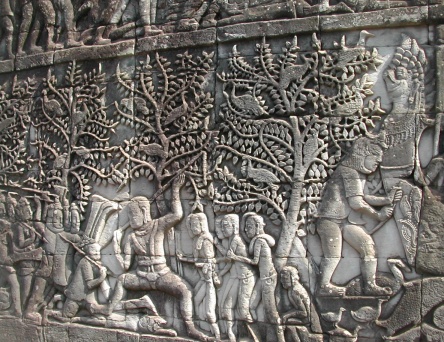
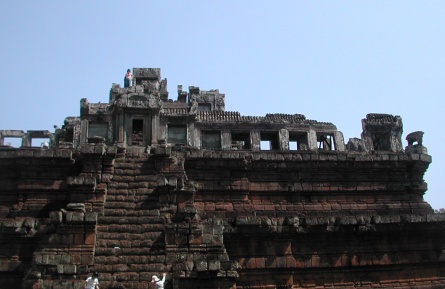
This palace was originally built by Suryavarman I in the early 11th century. The palace continued to be used – with a few interruptions – until the late 16th century.
The outer walls are nearly 17 feet high. They run over 800 feet in a north-south direction and almost 2,000 feet in an east-west direction. They enclose an area more than 35 acres. This is the largest enclosed area within Angkor Thom.
Most buildings here were not religious buildings. Therefore, they were not constructed of stone, and they have disappeared over time. However, evidence of many buildings remains. The most interesting remains are of the Temple of Phimeanakas and the large pond whose south wall is carved with bas-reliefs.
The temple is atop a 120 foot pyramid. Atop the pyramid are the remains of the sandstone gallery which are probably not as old as the pyramid on which they sit. There is a legend of women being the incarnation of the nine-headed naga and the king’s folly with these women in the Phimeanakas, but it is likely as accurate as most legends.
The large pond is one of three surrounding the former palace. It was probably built by Jayavarman VIII. The south wall is seemingly a retaining wall, and it is beautifully carved. Atop the wall is a terrace from which the king could oversee the pond and its activities.
The Leper King Terrace is a massive terrace that is part of the structure surrounding the Bayon within Angkor Thom. It is, though, somewhat independent of the central structures.
Historians disagree about the naming of this terrace. Some suggest that it was named after King Yasovarman I who may have died of leprosy, but others claim that is merely folk legend. Some say that it was named after the 15th century sculpture that was once on top of it (now in the National Museum in Phnom Penh). The sculpture is probably Dharma or Yama – god of the Underworld – but its face has been corroded by patches of lichen. Those patches were interpreted by some as leprosy. It may never be known.
The age of this structure is also uncertain. It was probably built during the reign of Jayavarman VIII during other significant alterations he made to the royal palace.
There remains uncertainty of the origins of its name and age. However, most agree that this was the royal cremation site.
The Elephant Terrace – just north of the Bayon and south of the Leper King Terrace- is a 1,000 foot long terrace that forms the western edge of the Royal Square. There are five staircases leading up to this terrace that was used for royal receptions. It is called the elephant terrace because of its many elephant carvings; however, it has numerous other carvings as well. It would have been a spectacular reception site.
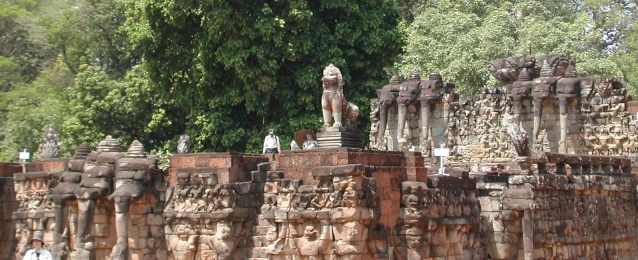
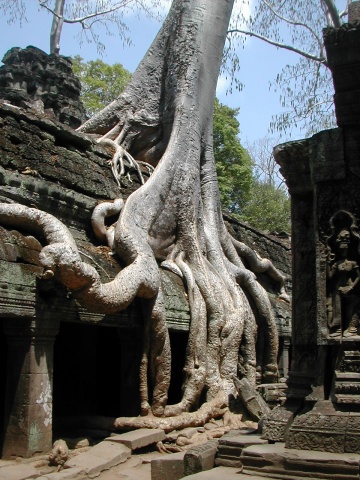
Outside of Angkor Thom, and only about one mile to the east is Ta Prohm. This temple was built by the prolific Jayavarman VII and dedicated to his mother. When built, the temple reportedly had thousands of pearls, precious stones, and golden dishes weighing more than 1100 pounds. These are now all gone, but one can still see the indentations in the walls where they had been inset.
This temple is markedly different from the other temples of Angkor because it is intentionally unrestored. It has been left in its ‘natural state’ as an example of how most Angkor temples looked when rediscovered in the 19th century. However, despite its ‘natural’ appearance, it has required substantial work to clear enough vegetation to make it accessible and prevent further collapse.
Two types of trees have intertwined among the ruins at Ta Prohm. The larger tree is the silk-cotton tree (Ceiba pentandra), and the smaller tree is the strangler fig (Ficus gibbosa). Over time, the roots of these trees have grown between blocks, and they are forcing blocks apart as they continue to grow. So long as the trees remain alive, they serve to support the encased temple. However, when the trees die, the buildings within their embrace will likely collapse. For now, this temple’s condition of seeming neglect has created an atmosphere that is even more surreal than that of the other larger temples.
The original outer wall of this temple complex enclosed more than 160 acres and an inhabited city of thousands. Multiple inner walls were constructed which enclosed progressively smaller areas and 60 surrounding shrines. The temple itself, at the core of the complex, occupies only 2.5 acres.
This is now a relatively small temple complex, and we thought it was a bit disorienting. Possibly it was the closely spaced buildings. Possibly it was the trees. At any given time, we would probably have had difficulty finding our way out without a guide. It was other-worldly, almost eerie, and quite different.
We were told that this temple was used for filming much of Angelina Jolie’s ‘Tomb Raider’ flick. We haven’t seen the movie, but it would surely make a dramatic movie set.
Angkor Wat is the largest religious monument in the world. Its outer dimensions are 2.2 miles in each direction giving it an area of almost five square miles. Just the moat is nearly 600 feet across.
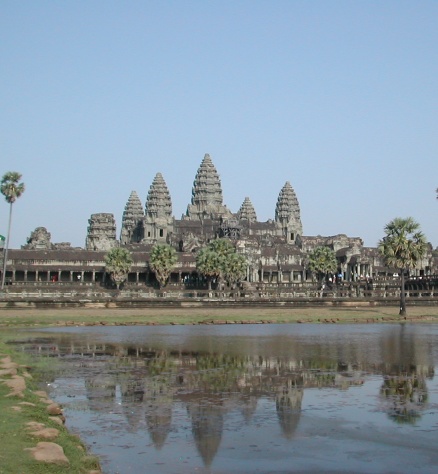
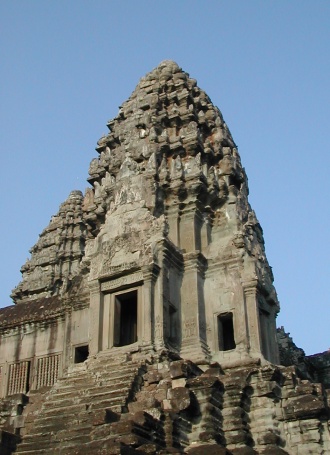
It was built between 1113 and 1150 by King Suryavarman II, a Hindu, and dedicated to Vishnu. Although it was King Suryavarman II’s capital and state temple during his lifetime, work stopped when he died, and some areas were not completed. It was sacked by the Chams in 1177, and when the Khmer empire was restored by Jayavarman VII, he built his own capital and state temple at Angkor Thom.
Angkor Wat is a microcosm of the Hindu universe. The walls and moat symbolize the mountains and oceans, and the five peaks in the center symbolize Mount Meru.
The temple itself combines two common features of Khmer architecture – the pyramid and concentric galleries. Angkor Wat is essentially a three-level pyramid with each level enclosed by a gallery. The five towers are atop the summit.
Unlike most Khmer temples, Angkor Wat is oriented to the west rather than the east, and there is disagreement over the significance of that. Some point out that Angkor Wat was dedicated to Vishnu whom was associated with the west. Others suggest that Suryavarman II intended Angkor Wat to be his funerary temple, and rituals occur in reverse during Brahmin funerals. There is further support for this idea in the counter-clockwise progression of the bas-reliefs. It is not known.
Bas-reliefs cover the exterior walls of the third enclosure. These are mostly, but not completely, from the Hindu epics of Ramayana and Mahabharata. The two panels that are not derived from Hindu mythology are are on south gallery. On the western end is the Historic procession of Suryavarman II, and on the eastern end is Heavens and Hells These bas-reliefs are more than 6 feet tall, and they total almost 2,000 feet in length. The architecture and detail of Angkor Wat are beyond compare, and the detail of the bas-reliefs must be seen to be believed. It is spectacular!.
Angkor Wat has become a national symbol for Cambodia, and it has been on the Cambodian national flag since 1863. It is also Cambodia’s primary tourist draw. It is deservedly a source of great national pride.
Return to our Cambodia page, our Vietnam page, or our home page.